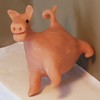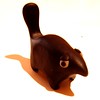How I Make Creatures That Aren’t Cats
I’m a cat person; I always lived with cats when I was a kid, and their moods and body languages are deep-seated in my psyche. If I just sit down to doodle with a lump of clay, a cat tends to be what comes out. That’s no excuse though! This world is full of interesting creatures which aren’t cats, with many more imaginary beasts noodling around in our collective consciousness – so I often make an effort to sculpt other critters.
Much of what I wrote in How I Make Cats applies more-or-less across the board, so rather than going in to great detail about every beastie you might like to make, I am instead going to try to summarise what makes them unlike cats to sculpt, looking at distinguishing features rather than techniques…
 Dogs
Dogs
Quite a lot like cats, superficially – but the snout and the floppier, less-pointy ears make all the difference to their faces, the body language of dog-tails is quite different from that of cats (although it is not unrelated) and their legs are a bit meatier. Fish
Fish
The sinuousness of the fish is quite pleasing, although its lack of limbs somewhat narrows the range of possible creative expression. On the other hand fish, more than almost any land animal, invite boundless creativity on the colouring front, and eyes can say a lot – especially if you take a cavalier attitude to the question of whether fish should have eyelids. One tricky thing about making free-standing fish is to make sure they’re either curvy enough or fat enough not to topple over. If you’d rather they go on a wall or something like that, you’ll want to think about fixing a loop of wire or a magnet to the back. Pigs
Pigs
Pigs are sort of like really fat, pinkish cats with flattened snouts, beady eyes (for which the easiest thing is probably to use actual beads) and little curly tails. They also have trotters rather than paws, if you’re into that level of detail, and their ears stick out a lot more. Beavers
Beavers
The national animal of Canada! The humble beaver is perhaps the gnawingest of all beasts. Its main distinguishing feature is its broad, flattish tail. It also has a sort of blunt-ish, snuffly snout, and to make their beaverishness obvious you might like to give them two prominent front teeth – although they don’t really stick out that much in real beavers. Lizards
Lizards
Lizards are fun. Low on the ground, their legs protrude from their sides and their serpentine bodies make for lovely dynamic curves. Sometimes I might give a lizard a spiky spine, pinching vertebrae out of the flesh of its back, but they don’t always need it. Dinosaurs
Dinosaurs
Like many people, my mind is occasionally occupied by velociraptors, with the odd hadrosaur also passing through from time to time. Paleozoological rectitude has never been a major concern of mine, so I freely make nameless dinosaurs which sit on their haunches or stand on two feet and a tail, roaring, waving little arms in front of them, and generally trying to look threatening. Dragons
Dragons
A perennial favourite, most people who ever sculpt in polymer clay at all probably end up making dragons at some point. They take more work than most of the things I make, thanks to the wings, tails and facial detail – the things that make something identifiably a dragon, and not just a confused dinosaur. There’s plenty of latitude in making dragons though, in the absence of any real-world reference there’s nothing much to stop you from saying ‘well my dragon is fluorescent pink, with two tails and a head like a ferret’s.’ Demons
Demons
Being both mythical and endlessly various, demons basically allow totally free rein to the imagination. Often they have claws or horns, which you can make by extruding nodules from the clay and then pulling and squeezing and rolling the ends until they are sharp and fearsome, or make separately as tiny little cones, which it’s sometimes worth cooking in advance so that they don’t buckle when they’re attached – a trick which is even more worthwhile with sharp teeth. The monstrosity of demons invites doodling and experimentation; I leave the details up to your subconscious.
Most generally, if I don’t feel like I’ve got a handle on what would make it obvious that a given clay creature is supposed to be the animal I’m aiming for, I run a Google Image Search and maybe check out Wikipedia, which usually has a couple of good pictures.